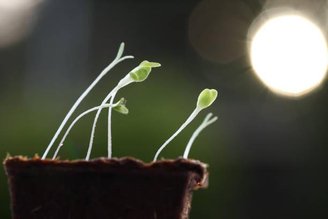A team of researchers recently proposed a new farming method called electrofarming that promises to completely overhaul known forms of agriculture on Earth and perhaps lay the foundation for a new way to grow food in space. This technique could definitively eliminate the two biggest challenges faced by producers today: dependence on climatic conditions and the need for large areas of land.
This ambitious new method proposes to replace traditional photosynthesis, in which plants use sunlight to convert carbon dioxide (CO2) and water into glucose, with a “shortcut” of sorts. We are the ones who will carry out the chemical transformation of carbon dioxide in a specific organic molecule with which we will “feed” the plants.
In a press release, researchers make a surprising prediction: “If all food in the US were produced using electric farming, acreage would be reduced by 94%”. When less land is needed for agriculture, we can return large areas to nature, helping to both preserve biodiversity and mitigate climate change.
How does electrofarming work?

Having completed the bold goals of their project, the authors want not only to reproduce photosynthesis, but also to increase its efficiency. In this sense, St. Co-author Feng Jiao from Washington University in St. Louis assures: “We are already at around 4% efficiency, which is four times more than photosynthesis. [tradicional]”, celebrates the electrochemist.
But in order for plants to agree to “eat” the acetate, They had to genetically adapt to it. The researchers took advantage of the metabolic pathway that plants normally use when they are unable to photosynthesize when they are young. This pathway, which allows the plant to break down the nutrient reserves stored in its seed and use it to produce energy and carbon, is turned off when it develops green leaves.
According to Jinkerson, “We are trying to reactivate this pathway in adult plants and stimulate their natural ability to use acetate.” He compares the mechanism to lactose intolerance in humans. As babies, we use an enzyme called lactase to break down the lactose (sugar) in milk, but in some people the body “turns off” this function.
Electrofarming: next steps

The team has already designed plants that use acetate and photosynthesis, but The idea is to eliminate the need for light by obtaining all the energy from acetate.. They are working with tomatoes and lettuce for now, but will soon switch to high-calorie crops such as cassava, sweet potatoes and grains.
According to Jinkerson, the “acceptance” of acetate by plants, a crucial step in the process, remains in the research and development phase. The difficulty arises from the nature of plants, which have not evolved to consume acetate. “Fungi, yeast and algae can be grown this way today,” the biological engineer assures.
The study was published in the journal Joule.
Did you like the content? So stay up to date on science and technology at TecMundo. Until next time!
Source: Tec Mundo
I’m Blaine Morgan, an experienced journalist and writer with over 8 years of experience in the tech industry. My expertise lies in writing about technology news and trends, covering everything from cutting-edge gadgets to emerging software developments. I’ve written for several leading publications including Gadget Onus where I am an author.












